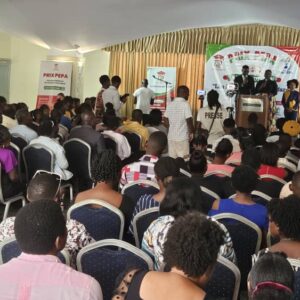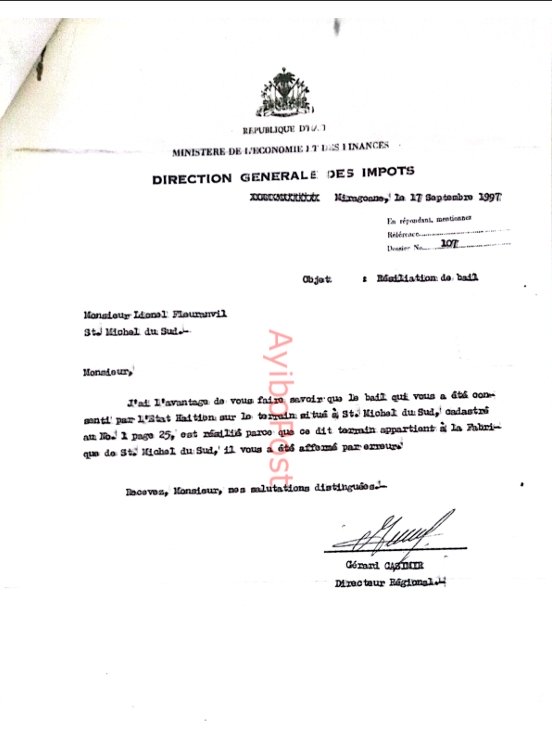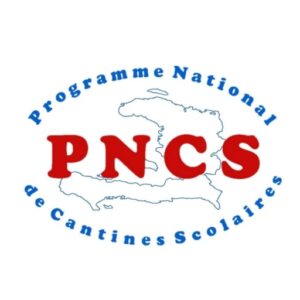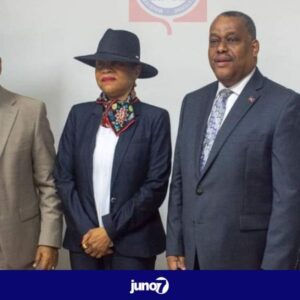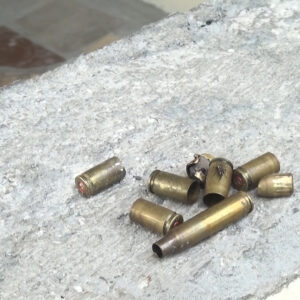The local head of the General Directorate of Taxes, Jean Richard Bienvenue, backs the farmers in this matter. “All the land in Saint-Michel cannot be the property of the Catholic Church,”[…]
The Catholic Church claims to own 236 hectars of land in Nippes.
The institution’s legal representative is in the process of expelling citizens from the grounds, including peasants he deems to be illegally occupying the land.
Some of the occupants have lived on these lands in the fourth communal section of Miragôane for several decades.
Others dispute the status of farmers on plots they say belong to the State.
The Church’s lawyer in this matter, also the parish priest of Saint-Michel Archange, Father Robenson Grégoire, told AyiboPost he had documentation proving the State’s donations, but did not want to release them.
However, documents obtained exclusively by AyiboPost, as well as interviews with ecclesiastical authorities, public administration, and residents of the region, unveil a more complex matter.
The institution’s legal representative is in the process of expelling citizens from the grounds, including peasants he deems to be illegally occupying the land.
According to available documentation, even the Haitian State seems confused about the Church’s right to certain portions of the disputed land, including about 170 hectares allegedly given to the clergy by Haiti’s first president, Alexandre Pétion.
The case of 64-year-old Lionel Fleuranvil exemplifies this confusion.
The farmer had been a state farmer since January 5, 1988.
But, on September 17, 1997, the regional director of the General Directorate of Taxes (DGI) at the time, Gérard Casimir, sent him a letter entitled “termination of lease.”
According to the letter delivered to Fleuranvil, the State had leased the land to him “by mistake” and he now had to refer to the Fabrique de Saint-Michel des Nippes for any negotiations in this matter.
Gérard Casimir sends a letter to Fleuranvil entitled “termination of lease”.
La Fabrique — an ecclesiastical institution — administers the Catholic Church’s property in the area. Father Grégoire has presided over the Fabrique de Saint-Michel since October 9, 2019.
The letter from the DGI sent to Fleuranvil followed a written request from the then parish priest of Miragôane, Jean Vanès Nicolas, to the director general of the institution on June 9, 1997.

Land conflict
The priest wanted the lease terminated, and the reintegration into the church’s estate of the land rented out by the DGI “no doubt under political pressure,” after the American occupation.
On September 9, 1997, the then director general of the DGI, Jocelerme Privert, ordered the regional director to terminate the farm leases entered into “by mistake in the name of the State,” according to an official document obtained by AyiboPost.
Since then, Fleuranvil has paid an annual lease to the Catholic Church.

On September 9, 1997, Jocelerme Privert, director general of the DGI at the time, asked the regional director to put an end to the farm leases concluded «by mistake» in the name of the State.
Contacted by AyiboPost, the former director of the DGI and former president Jocelerme Privert did not comment.
Three years ago, Father Robenson Grégoire took possession of part of Lionel Fleuranvil’s land and several other farmers of Saint-Michel des Nippes for the construction of a public market.
The public market was never built.
And the portion claimed by the church was redistributed to public institutions for the construction of offices and to other farmers.
Lionel Fleuranvil as well as dozens of citizens of Saint-Michel des Nippes are contesting the extent of the land holdings of the Catholic Church, on land sometimes not used for decades.
Father Grégoire claims to have survey documents for about 180 hectares of land.
However, he says, people from the community occupy almost all of the land of the Fabrique de Saint-Michel.
According to the Church, around 170 hectares were donated by the state and about 65 additional hectares from a major landowner.
AyiboPost’s requests to Father Grégoire for documents proving these donations were unsuccessful.
“Any donation must be made before a notary and declared to be legal,” maintains Maître Rosental Duvelsaint, notary public in Verrettes.
According to the expert, it is possible that the Catholic Church does not have a title to the property.
“To obtain this title, you need a definitive deed drawn up by a notary public, accompanied by a survey registered with the DGI,” analyzes Duvelsaint, adding that the church must at least have a deed of donation.
Beyond the area in dispute, the diocese of Anse-à-Veau and Miragôane owns a lot of land in Nippes.
Under the presidency of former President Jovenel Moïse, the Haitian State granted almost 1,032 hectares of land to the Catholic Church in the Baco Noir area in Miragôane, according to Father Grégoire.
Some farmers accept the status quo.
Fleuranvil, for example, does not intend to sue the Catholic Church to once again become a state farmer on the plot he has occupied for 30 years.
“The Haitian State and the Catholic Church are one,” believes the man for whom there’s no possibility of a trial.
Read also: Will the “bwa kale” movement pick up steam?
Other farmers resist.
The inhabitants of Baco Noir prevented at least one of the Catholic Church’s projects in collaboration with an organization, reports Father Grégoire, also notary of the diocese of Anse-à-Veau and Miragôane.
Sometimes, residents of the area like Professor François Bléus turn to the courts to settle these matters.
The man had been paying the DGI for [a plot] of land since 2012.
But in 2020, Father Robenson Grégoire and his team recovered part of his land, in the church’s offensive against the alleged squatters.
Farmer Lebert Simpris claims to have occupied his portion of land since 1973. He refuses to bow to the orders of the church.
“Father Robenson is creating disorder in Saint-Michel, reproaches the farmer. He seizes the land of poor peasants to resell it to wealthy people.”
On December 8, 2022, Simpris asked the DGI to recognize the land as State property and to survey it.

Lebert Simpris’ letter addressing the DGI regarding his land dispute with the Catholic Church dated Thursday, December 8, 2022.
In protest, Simpris and four other people occupying the area reclaimed by the priest piled materials on the land for future construction.
Pirame Lagirois, retired professor after 36 years of service to the State, declares himself a victim of “Grégoire’s operations.”
The departmental coordinator of the National Federation of «Normaliens» of Haiti (UNNOH) occupies more than 2.58 hectares of land in Sicily, bordering Saint-Michel.
Father Grégoire, according to Lagirois, cut off a piece of his land “which belongs to the State” to resell it to an individual for several tens of thousands of dollars.
The priest rejects the notion of sale to AyiboPost, but instead speaks of leasing for the benefit of the entrepreneur Verdieu Saint-Louis, without revealing the amounts involved.
This matter is before the courts.
However, other sales are confirmed.
Miragôane notary Mario Joseph reveals to AyiboPost that the priest presented himself in his office with a special power of attorney from Monsignor Pierre-André Dumas to order the sale of land to five people on December 21, 2023.
Father Robenson Grégoire does not intend to turn back.
The money collected, according to the prelate, finances church activities.
For example, the parish started rebuilding a year before his arrival at Saint-Michel Archange in 2019. Father Grégoire wants to complete these works.
Renting land should help the initiative, according to the priest. “Se grès kochon an k ap kuit kochon an [The pigs fat will cook the pig]” he told AyiboPost.
With Monsignor Pierre-André Dumas’ approval, Robenson Grégoire barters with certain individuals who want a legal title for their plots.
The latter provide materials such as iron and cement for the construction of the church. Then, the church representative appears before a notary with the buyer to legally provide him with a legal title.
The church’s 420 farmers must pay annual fees. Most of those who refuse to pay are evicted and the land handed over to other takers.
The cemetery in the area is located on land belonging to the Parish of the Catholic Church. Residents must pay up to 15,000 gourdes for each burial, according to testimonies.
Father Grégoire confirms that an amount must be paid, but claims to only receive a fee of 500 gourdes to bury a corpse in the cemetery. This fee finances the cleaning services, according to Father Grégoire.
The land question remains thorny in Haiti.
Immediately following the dismantling of the colonial system in 1804, this question created disputes between the old and the new free people.
Disputes of this type become even more serious due to the absence of a land registry throughout the national territory.
The Catholic religion played a decisive role during slavery. It maintained and extended its influence after the revolution.
According to Father Robenson Grégoire, the church holds many privileges in Haiti.
The man of God mentions the Accord of March 28, 1860 signed with the Haitian State which asks it to build churches and presbyteries for the Catholic Church and to remunerate priests in a context where the religious institution plays an important role in education.
Read also: A teacher’s covert journey from Barbecue’s stronghold to Santo Domingo
According to attorney Samuel Madistin, in asserting the equality of religions, the 1987 Constitution calls this accord into question in Article 30.
“The budgetary support granted to Catholic priests by the Ministry of Religious Affairs is now irregular and must be stopped, unless the State grants exactly the same privileges to pastors, voodoo priests, leaders of the Muslim community, and Jehovah’s Witnesses,» according to Maître Madistin.
The Catholic Church can count on a major ally in its conflict with citizens, including farmers, in the fourth communal section of Miragôane.
Several residents of Saint-Michel des Nippes identify the head of the Miragôane public prosecutor’s office, Jean Ernest Muscadin, as a close friend of Father Robenson Grégoire.
Muscadin, known for his extrajudicial executions of gang members, admits to having good relations with the priest, since he has lived with the latter for nine months.
Read also: Michel Chancy looks to Lèt Agogo to feed Haiti
On March 11, 2023, the influential commissioner intervenedin the conflict in person for the benefit of the Catholic Church, impeding a DGI surveyor’s intervention requested by the farmers.
The head of the Miragôane Public Prosecutor’s Office says he is aware of the sale of land by the Catholic Church — “a local authority bought a plot there,” he adds to AyiboPost.
“The Catholic Church offered me 2.5 hectares of land. I refused them,” maintains Jean Ernest Muscadin. (Father Robenson Grégoire rejects this allegation).
According to Commissioner Muscadin, the lands belong to the Catholic Church. But since these are state donations, he sees no pro blem with the population occupying them, he added during an interview with AyiboPost.
The relationship between the powerful commissioner and Father Grégoire seems to be growing cold.
The government commissioner declares having cut ties with the cleric because the latter prevented him from eliminating “Bonhomme […],” a notorious bandit in Saint-Michel des Nippes.
The Catholic Church offered me 2.5 hectares of land. I refused them.
– Jean Ernest Muscadin
According to Muscadin, Father Robenson Grégoire begged for forgiveness for the individual.
“Even I could be a victim of Bonhomme’s abuses,” says Muscadin.
The commissioner says he continues to track Bonhomme, but says he has not yet found an opportunity to apprehend him.
Father Robenson Grégoire denies having requested a pardon for Bonhomme.
“I can confirm that I had expressed the desire to accompany Bonhomme in court as a lawyer, having the right to accompany any client,” Father Grégoire told AyiboPost.
“He’s a citizen I know well, declared the priest. One of his parents was a member of the Church.”
The head of the Miragôane Public Prosecutor’s Office says he is aware of the sale of land by the Catholic Church – “a local authority bought a plot there.”
Even public institutions must count on the generosity of the Church to find land to build their offices in Saint-Michel des Nippes.
According to documents obtained by AyiboPost, structures such as the National Directorate of Drinking Water and Sanitation (DINEPA)/OREPA Sud, the Workplace Accident, Sickness and Maternity Insurance Office (OFATMA) or the Office of the Saint-Michel des Nippes school district, have appealed to the Church in this regard.
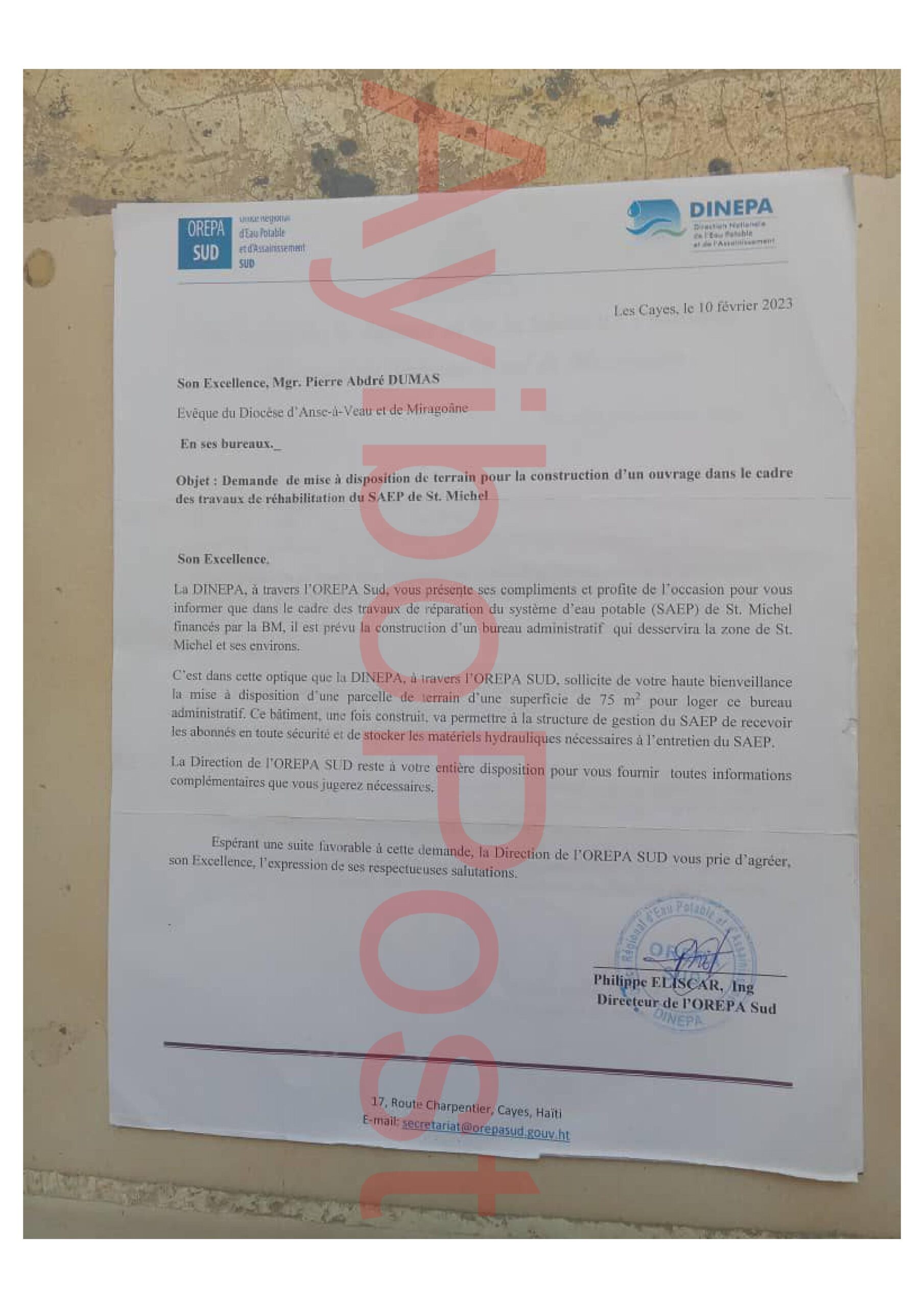
A letter from DINEPA requesting land from the Catholic Church in Saint-Michel des Nippes for the construction of an administrative office in the area, February 10, 2023.

A request from OFATMA to the Catholic Church in Saint-Michel des Nippes for a parcel of land for the construction of a hospital.

A letter from the Saint-Michel des Nippes School District to the Catholic Church requesting land for the construction of an office, March 3, 2023.
According to a letter addressed to the bishop of the diocese of Anse-à-Veau and Miragôane dated February 24, 2023 and obtained by AyiboPost, Commissioner Muscadin asked the Catholic Church for a plot of land for the construction of a court in Saint-Michel des Nippes.

The letter from Jean Earnest Muscadin requesting land from the Catholic Church in Saint-Michel des Nippes for the construction of a court, February 24, 2023.
The bishop of the diocese of Anse-à-Veau — Miragoâne, Monseigneur Pierre-André Dumas, mandated Father Grégoire to draw up contracts and to represent the parish of Saint-Michel Archange in court.
Contacted by AyiboPost, the bishop did not comment.
Local organizations side with the farmers.
In November 2022, the Nippoise Solidarity for Human Rights (SONIDH) denounced Father Grégoire’s actions deemed “reprehensible” in a letter sent to Monsignor Pierre-André Dumas and to the departmental director of the DGI.
According to the coordinator of SONIDH, Marc-Arthur Bien-Venu, the Catholic Church does not own the entire expanse of land that it claims in Saint-Michel des Nippes.

Letter from the Nippoise Solidarity for Human Rights (SONIDH) to the Diocese of Nippes regarding Father Grégoire’s actions, November 28, 2022

Jean-Richard Bienvenu’s letter to the DGI regarding Father Gregoire’s evictions on behalf of the Catholic Church in Saint-Michel des Nippes, November 10, 2022

Jean-Richard Bienvenu’s letter to the DGI regarding Father Gregoire’s evictions on behalf of the Catholic Church in Saint-Michel des Nippes, November 10, 2022
Because of the involvement of surveyors and notaries in this land conflict, the DGI’s central management as well as the Ministry of Justice and Public Security are aware of the case, according to Jean Richard Bienvenu for his part.
AyiboPost was unable to collect information on the evolution of the case at the level of these two institutions.
But locally, DGI’s reading seems to be in favor of farmers and citizens.
According to regional director of the DGI, Jean Richard Bienvenu, the priest does not know the boundaries of his church’s land.
“Not all of the land in Saint-Michel can be owned by the Catholic Church,” says the official.
Cover image published by AyiboPost illustrating the land conflict between peasants and the Catholic church of Nippes. The people in the image are not actually actors in the conflict.
Keep in touch with AyiboPost via:
► Our channel Telegram : Click here
► Our Channel WhatsApp : Click here
► Our Community WhatsApp : Click here


